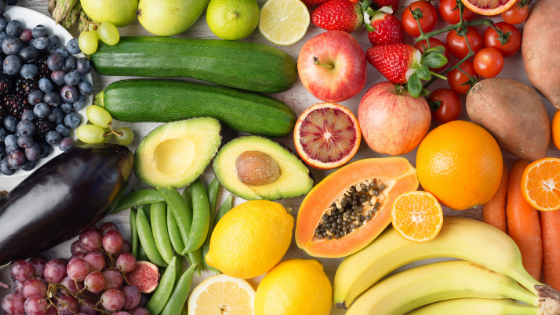Fall leaf color is something so many of us in Virginia anticipate, and thoroughly enjoy, for the brief, but (usually) spectacular, period before the trees retreat for their winter dormancy. When I glimpse an exceptionally vivid tree glowing yellow, orange or red, it seems almost miraculous. Yet, it is actually chemistry and biology in action.
Most of the colors are created by chemicals that already exist in the leaves. As the weather turns colder and days grow shorter, the energy-producing chemical, chlorophyll, begins breaking down, allowing the yellow and orange colors of other chemicals in the leaves to shine through. Red leaf colors occur by the activation of subsequent chemicals.
In the same way that the chemicals in leaves cause the production of energy and nourishment for the tree, these very chemicals in the vegetables and fruits we eat provide our bodies with the sustaining energy they need to heal. Not only do they provide macronutrients like protein, fats and carbohydrates, they also provide micronutrients like vitamins, minerals and phytonutrients. Phytonutrients are plant-derived compounds that support life – whether it is plant life or animal life – or your life!
Phytonutrients provide protection from oxidative stress. It may not sound ominous, but oxidative stress is one of the major causes of degenerative diseases like diabetes, heart disease and cancer. As an example, one type of phytonutrient, called polyphenols, while they do not provide energy or actual nutrition, have been found to be powerful antioxidants and anti-inflammatories. Antioxidants are molecules that help protect your cells from the daily damage caused by free radicals.
Here’s a breakdown of how the colors in plants are related to specific phytonutrients that help us heal and renew ourselves:
- Green foods such as broccoli, cabbage, kale, spinach and chard produce such phytonutrients as chlorophyll (the main green producing chemical), lutein and zeaxanthin. Green foods help improve diabetes and immunity and protect against cancer.
- Yellow/Orange foods, such as carrots, oranges, sweet potato and peppers contain phytonutrients like beta carotene, flavones, curcumin and bromelain. These foods protect your intestinal lining, eyes and skin and help to improve immunity.
- Red foods, such as beets, pomegranates, raspberries, strawberries, tomatoes and cherries contain phytonutrients such as lycopene, nitrate and capsaicin. These foods protect the cardiovascular system and reduce the risk of cancer.
- Purple/Blue foods, such as blueberries, eggplant, red cabbage, red wine and cranberries are rich in antioxidants such as anthocyanidins and resveratrol and help to improve memory, protect against cancer and improve the intestinal system.
In a review of multiple studies (a meta-analysis) done in 2014, the British Medical Journal reported that the more vegetables someone eats, the lower their risk of all-cause mortality. Unfortunately, the National Center for Health Statistics reports that only 3 – 12% of Americans meet fruit and vegetable intake recommendations. We need to do better than that, considering all the toxins attacking our bodies today.
If you need more reasons to eat a wide variety of vegetables and fruit, read up on what the studies of our gut microbiome are revealing. The fibers of different vegetables become food for different varieties of bacteria in our gut. According to the Journal of Agricultural and Food Chemistry (as reported by the National Institutes of Health), people who eat a greater variety of plants, which in turn creates more variety of different strains of bacterial flora in their colon, have lower inflammation and hence a lower risk of the major degenerative diseases – diabetes, heart disease, cancer, and gastrointestinal disorders.
Most of us are creatures of habit and we easily fall into the routine of picking up the same groceries each week and eating much of the same types of foods. My challenge to you (and myself) is to pick a new vegetable each time you go to the market. When you get home, search some of the online recipe sites to find out how to cook it, or search for recipes that focus on vegetables you don’t normally eat. In the process, you may find your new favorite veggie dish … and get heathier as a nice side benefit!
Sources:
- Ercolini, D. and Fogliano, V. (2018). Food Design To Feed the Human Gut Microbiota. [online] US National Library of Medicine National Institutes of Health. Available at: https://www.ncbi.nlm.nih.gov/pmc/articles/PMC5951603/ [Accessed 1 Oct. 2019].
- Wholistic Matters publications by Standard Process, 2019
Liked this article? You may also be interested in What Is Leaky Gut and What Are Its Consequences?

